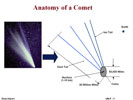Comets are the remainders of material formed in the coldest part of our solar system. Impacts from comets played a major role in the evolution of the Earth, primarily during its early history billions of years ago. Some believe that they brought water and a variety of organic molecules to Earth. Take a look at what Ancient Cultures thought of comets.
|
Comets are visible for two reasons. Dust driven from a comet's nucleus reflects sunlight as it travels through space. Secondly, certain gases, stimulated by the sun, give off light like fluorescent light bulbs. Over time a comet may become less active or even dormant. Scientists are anxious to learn whether comets exhaust their supply of gas and ice to space or seal it into their interiors. What is the difference between the interior of a comet's nucleus and its surface? Controlled cratering like that planned for Deep Impact allowed us to gather new information on comet Tempel 1. Take a look at our Mission Results.
Ray Brown discusses how the Deep Impact mission planned to meet its Science Objectives.
Comet Tempel 1 was discovered in 1867. Although few physical data are available, it appears to be a comet with relatively little surface activity. Orbiting the sun every 5.5 years, it has probably made more than one hundred passages through the inner solar system. This makes it a good target to study evolutionary change in the mantle or upper crust of the comet. Studies of brightness variations with time indicate that the comet rotates much more slowly than Earth. Its rotation will not take the impact crater out of the spacecraft's field of view during the encounter period.
 What is the difference between the nucleus of a comet and its core? The answer to this question along with many others can be found in our FAQ pages.
What is the difference between the nucleus of a comet and its core? The answer to this question along with many others can be found in our FAQ pages.
To learn more about other missions to comets and asteroids, please visit our Small Bodies Missions.











